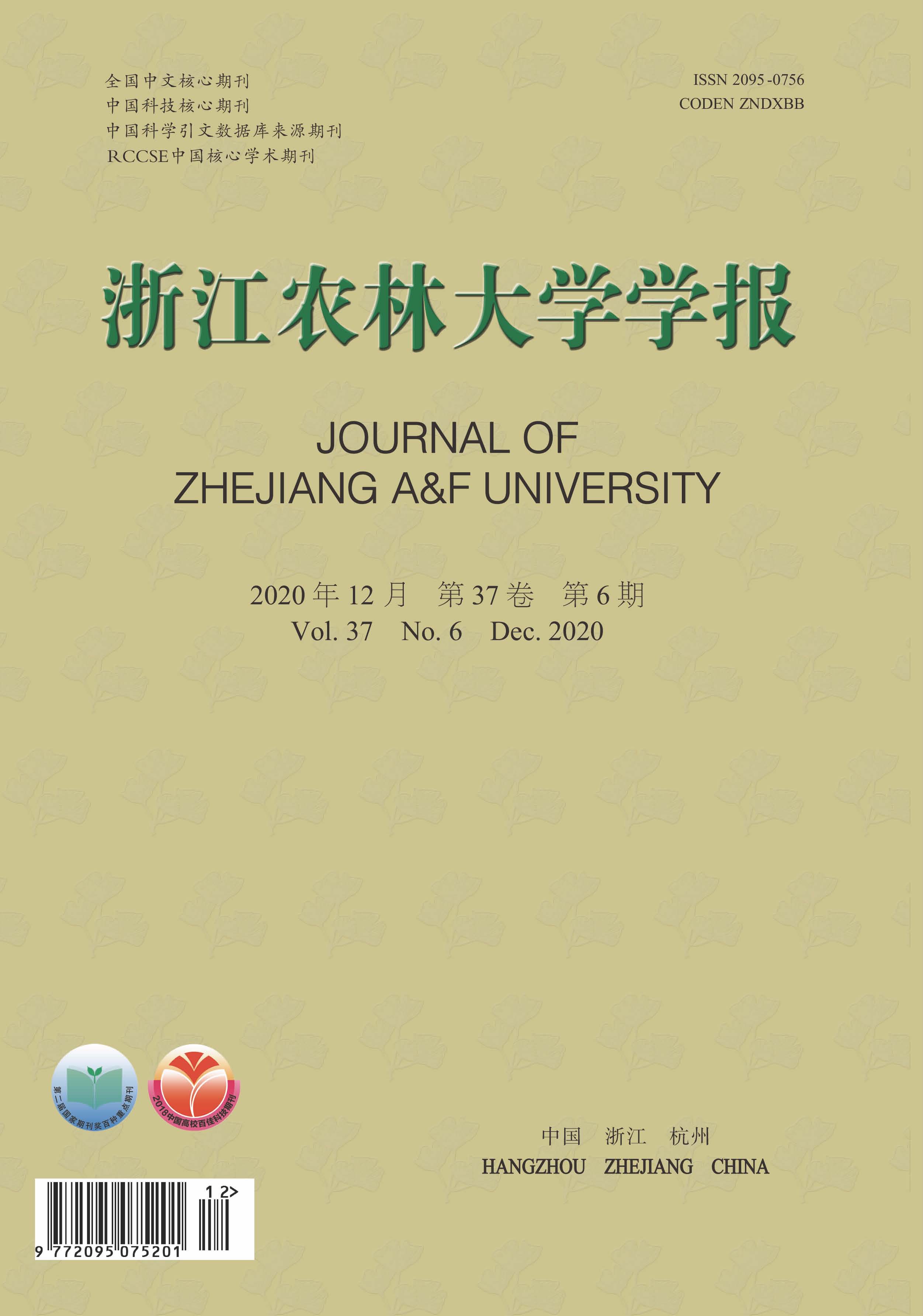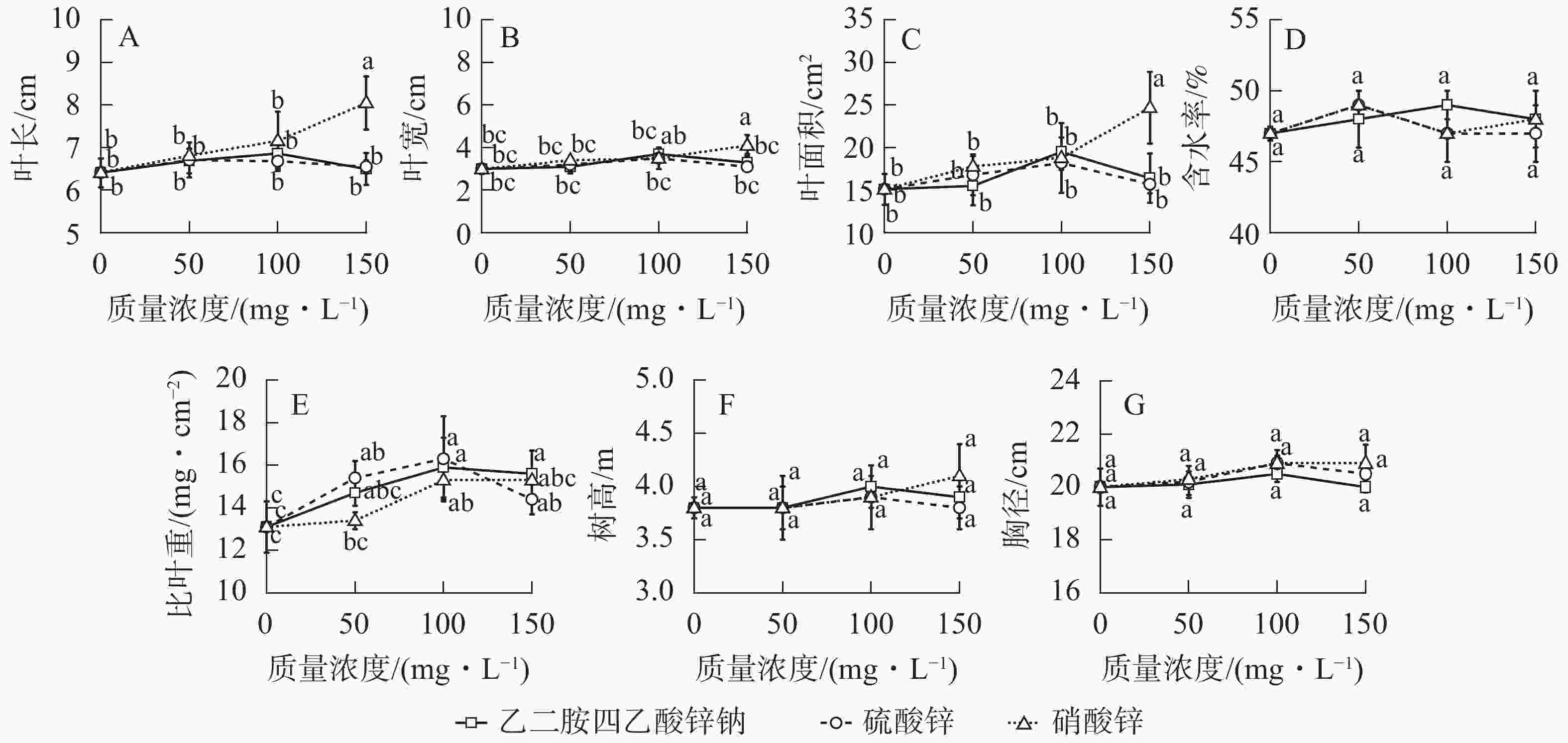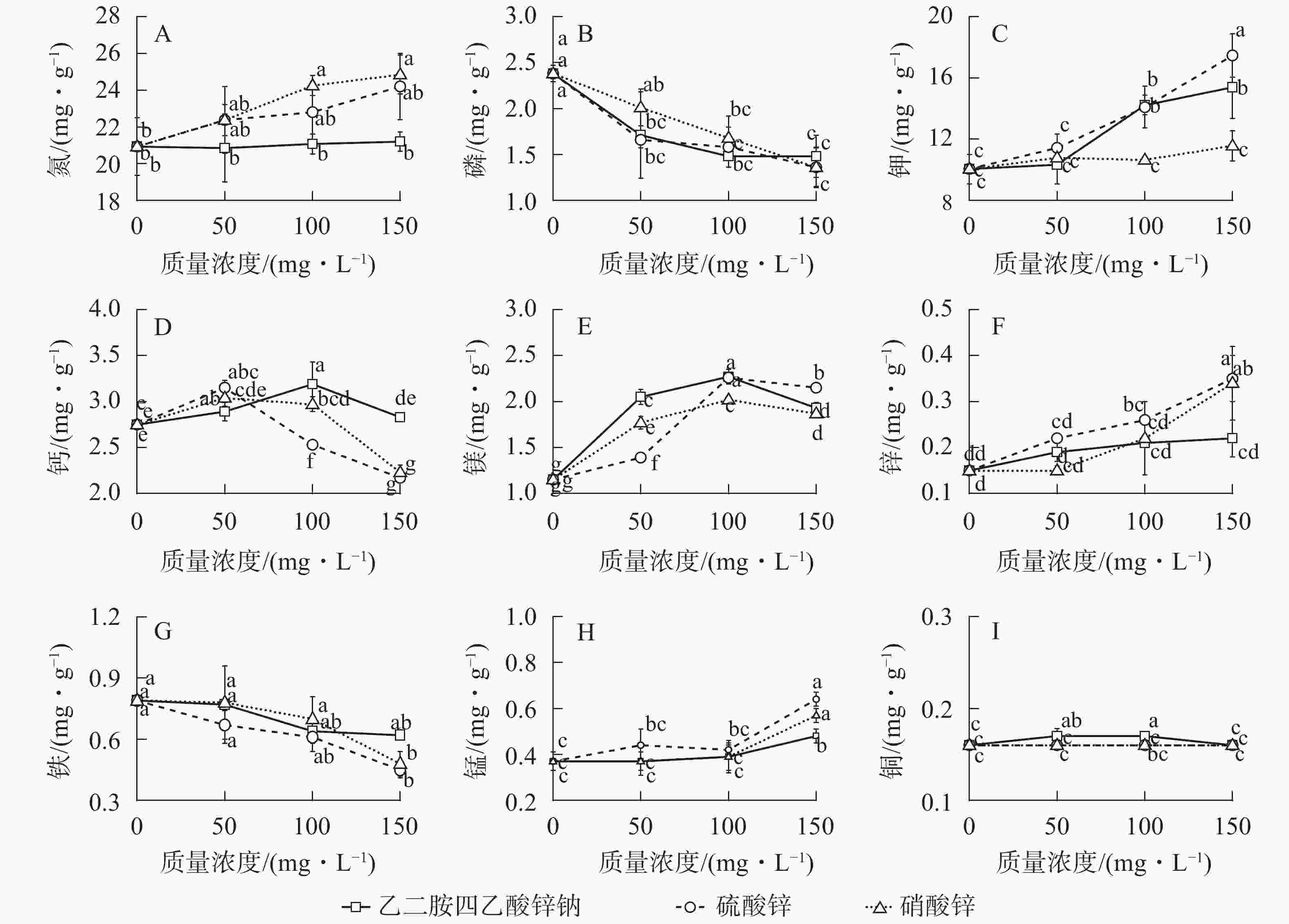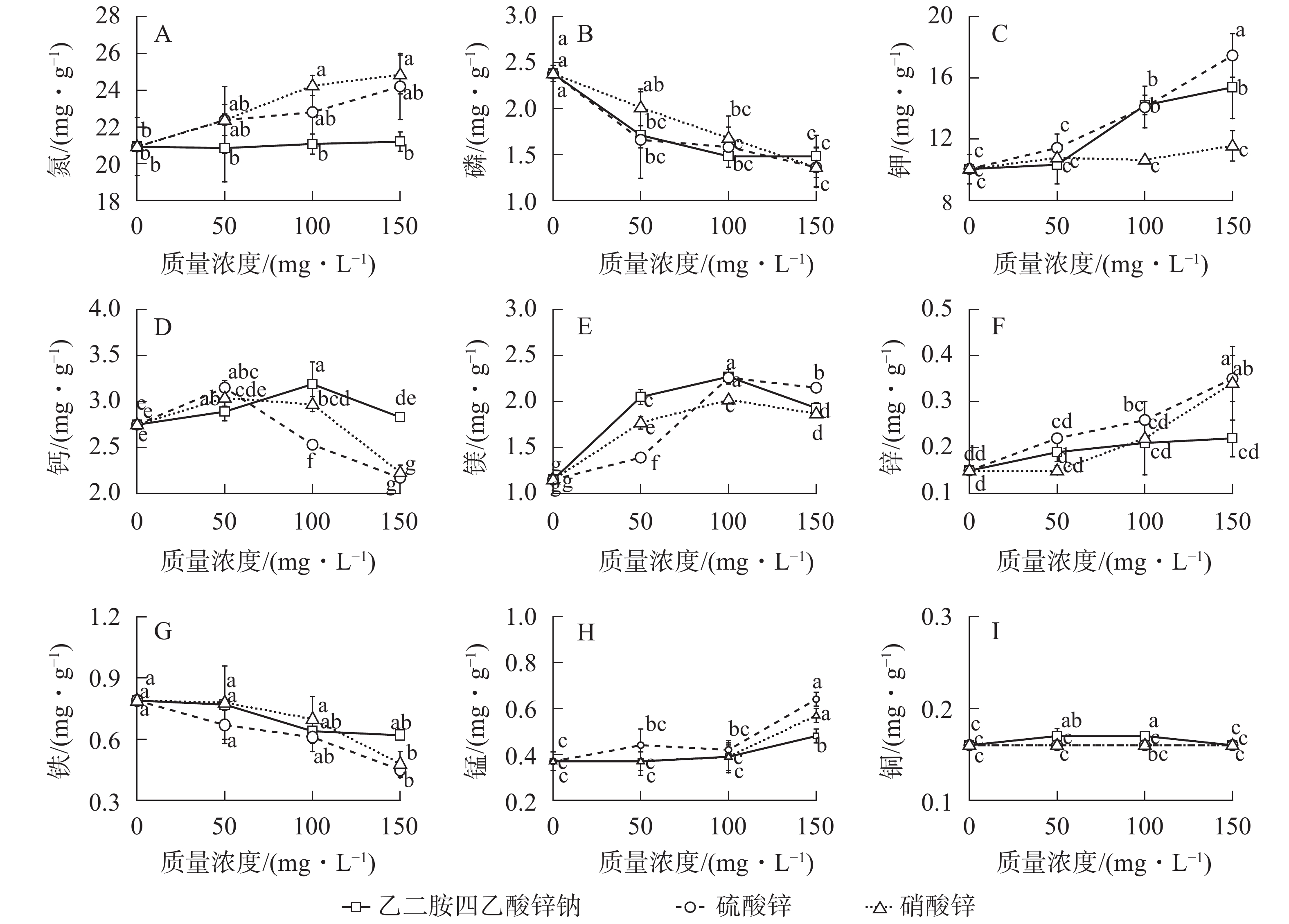-
锌是植物生长发育必需的微量元素,影响植物的许多生理过程,如光合作用、呼吸作用、氮素代谢及生长素的合成与代谢等,对200多种酶有重要的作用[1]。然而近年来,锌缺乏的现象越来越普遍和严重,已经成为限制农林业健康可持续发展的重要因素之一。据统计,全世界50%的作物种植区土壤存在缺锌或潜在缺锌[2]。中国缺锌土壤面积达4 866.7 万hm2,占全国可利用面积的45.7%。这一方面是因为中国南方高分化的酸性土壤和北方石灰性土壤中有效锌含量均较低,极大限制了农林业的产量[3-4]。另一方面是因过量施用氮磷钾复合肥而缺乏有机肥的施用等管理问题,导致土壤缺锌[5-6]。因此,合理增施锌肥等微量元素肥料成为快速缓解缺锌现状的首选,生产中常采用春季叶面喷锌和秋季土壤条施或滴灌方式补充,而叶面喷锌是公认的可快速缓解缺锌症状的管理措施之一[7]。有学者表明:施锌可以提高作物产量,且以叶面喷锌效果最佳[8-10]。薄壳山核桃Carya illinoensis又名美国山核桃或长山核桃,是集果用、材用和油用于一身的优良果树,也常做景观观赏树种[11]。原产美国和墨西哥北部,引种至中国已有100多年的历史,并从最初的零星栽种到现如今的规模化、产业化载植,已在中国22个省(区)打开了市场[12-13]。WOOD等[14]发现:生产中,薄壳山核桃对锌元素高度敏感,当其叶片锌含量低于40 mg·g−1时,会表现出典型的缺锌症状:小叶病,顶端嫩叶卷曲,顶芽枯死,萌芽困难,叶脉间变黄或坏死,叶片变窄,叶片厚度降低。这些症状致使果树光合能力下降,从而限制果树生长、开花和结实,特别是果树处于快速生长期时,这种缺锌现象更为严重[15]。可见,缺锌已成为限制薄壳山核桃果园产量和果实品质的重要因子之一。国外学者在薄壳山核桃果园增施锌肥方面做了大量研究,常采用硝酸锌、硫酸锌、乙二胺四乙酸锌钠(EDTA-Zn)、二乙烯三胺五乙酸锌钠(DTPA-Zn)等作为锌肥来源,与尿素、硼酸、超氨基等组合进行配比喷施肥,已取得了一定的成果[15-17]。而中国薄壳山核桃产业还处于起步阶段,在果园管理中,对锌肥种类及浓度的需求规律并不清楚。为此,本研究以6年生薄壳山核桃‘波尼’‘Pawnee’为研究对象,通过叶面喷锌的试验方法,探讨不同锌肥种类及质量浓度对其生长和矿质营养元素的影响,并采用主成分分析和加权隶属函数相结合的方法对喷锌效果进行评价,科学筛选出叶面喷锌的适宜锌肥种类及质量浓度,旨在为薄壳山核桃果园的丰产管理提供技术及理论依据。
HTML
-
研究区位于江苏省句容市后白镇张庙村,南京林业大学美国山核桃试验基地(31°52′45″N,119°09′06″E)。该区属北亚热带中部季风气候,年均气温15.6 ℃,年降水量1 018.6 mm,日平均气温大于10 ℃的天数为226 d,无霜期229 d。研究地属典型的低山丘陵地区,土壤为黄棕壤,中性偏酸。土壤铵态氮、有效磷和速效钾分别为22.65、3.07和25.31 mg·kg−1,pH 7.48。
-
供试树种为6年生薄壳山核桃‘波尼’。喷锌前,果树生长良好且一致,株行距为8 m×6 m。锌肥种类分别为乙二胺四乙酸锌钠(EDTA-Zn,锌质量分数21.7%)、硫酸锌(ZnSO4·7H2O,锌质量分数22.6%)和硝酸锌[Zn(NO3)2·6H2O,锌质量分数21.9%]。
-
试验采用2因素3水平试验设计方案,设10个处理(设锌肥种类与质量浓度2个因素,每因素设3水平,以不喷锌处理作为对照),3次重复,单株小区,完全随机区组分布,单株隔离保护(表1)。试验区内的土壤水分、肥力条件相对一致,且果园抚育管理措施一致。于2018年4月27日、5月8日、5月23日和6月4日,晴朗无风的清晨,用压缩背负式喷雾器将叶面喷施至微滴水,共喷施4次。
处理 锌肥种类 锌肥质量浓度/(mg·L−1) 对照 0 1 乙二胺四乙酸锌钠(EDTA-Zn) 50 2 乙二胺四乙酸锌钠(EDTA-Zn) 100 3 乙二胺四乙酸锌钠(EDTA-Zn) 150 4 硫酸锌(ZnSO4·7H2O) 50 5 硫酸锌(ZnSO4·7H2O) 100 6 硫酸锌(ZnSO4·7H2O) 150 7 硝酸锌[Zn(NO3)2·6H2O] 50 8 硝酸锌[Zn(NO3)2·6H2O] 100 9 硝酸锌[Zn(NO3)2·6H2O] 150 Table 1. Test design table of zinc fertilizer 2-factors 3-levels
-
2018年8月中旬,采集各处理树木的树冠外围中部长势一致的功能叶5片·株–1,各处理测定3株(3次重复),分别用于叶片生长及矿质营养元素的测定。
样品采集后装入塑封袋置于冰盒带回,用自来水和纯水分别冲洗干净,晾干。采用YMJ-D型手持叶面积仪(浙江托普仪器公司生产)和千分之一天平分别测定叶面积和叶片鲜质量。随后将新鲜叶片放置100 ℃烘箱杀青10 min,然后60 ℃下烘干至恒量。千分之一天平测定叶片干质量。研磨干样至粉碎,过100目筛,密封保存待用。2018年11月中旬,待叶片全部脱落后测定树高和胸径。
干样采用硝酸-高氯酸消煮,消煮液用来分析叶片矿质营养元素。单位质量叶片中的全磷质量分数用钼锑抗比色法测定,其他元素质量分数用原子吸收分光光度计(AES,英国PYE公司生产的SP9-400型)测定。单位质量叶片中的全氮质量分数(干样)用elementar MACRO cube元素分析仪(德国艾力蒙塔公司生产)测定。
-
数据用均值±标准差表示。采用Excel 2016、SPSS 23.0等对数据进行相关性分析、主成分分析,用Duncan’s新复极差法进行差异显著性分析(P<0.05)。采用Origin 9.1进行图形绘制。根据张婷等[18]的方法,将主成分分析和加权隶属函数法相结合进行综合指标评价,从而计算出10个叶面喷锌处理组的综合评价值(D)。
1.1. 研究区概况
1.2. 材料
1.3. 试验方法
1.4. 取样及指标测定
1.5. 数据分析及处理
-
薄壳山核桃叶片及树高、胸径指标均随着喷锌质量浓度的递增而增大,且硝酸锌处理的增长趋势更明显(图1)。在150 mg·L−1硝酸锌处理下,叶长、叶宽、叶面积和比叶重增长显著(图1A、图1B、图1C、图1E),分别超出对照的26%、37%、25%、17%(P<0.05)。喷锌质量浓度为50~100 mg·L−1时,叶片含水率最高(图1D),增长率并不受锌肥种类影响,均为4%。各处理组的树高和胸径增长均不显著。
-
随喷锌质量浓度递增,各处理组的单位质量叶片中氮、钾、锌、锰质量分数不断上升,钙、镁质量分数先升后降,磷、铁质量分数持续下降,铜质量分数维持稳定(图2)。喷锌质量浓度为150 mg·L−1时,乙二胺四乙酸锌钠、硫酸锌、硝酸锌处理组的单位质量叶片氮、钾、锌、锰质量分数均升至最高,分别超出对照1%、16%、19%;53%、74%、15%;47%、133%、127%;30%、73%、54%(图2A、图2C、图2F、图2H),且硫酸锌、硝酸锌处理组差异显著(P<0.05),而乙二胺四乙酸锌钠处理组差异不显著。喷锌质量浓度为50~100 mg·L−1时,乙二胺四乙酸锌钠、硫酸锌、硝酸锌处理组的单位质量叶片中钙、镁质量分数达到最高拐点,拐点增幅分别为16%、15%、11%和97%、76%、97%(图2D和图2E),差异显著(P<0.05)。喷锌质量浓度为150 mg·L−1时,乙二胺四乙酸锌钠、硫酸锌、硝酸锌处理组的单位质量叶片中磷、铁质量分数均降至最低,分别低于对照组38%、43%、43%和22%、43%、39%,且处理组之间差异不显著(图2B和图2G)。
-
薄壳山核桃叶片生长和矿质营养元素指标之间具有显著的相关性(表2)。叶长与氮、锌质量分数呈显著(P<0.05)、极显著(P<0.01)正相关,相关系数分别为0.437、0.474。叶宽与钙、锌质量分数呈显著正相关(P<0.05,相关系数为0.446、0.446)。叶面积与氮、钙、锌质量分数呈显著正相关(P<0.05,相关系数为0.372、0.395、0.483)。叶片含水率与磷质量分数呈显著正相关(P<0.05,相关系数为0.445)。比叶重则与钙质量分数呈极显著正相关(P<0.01,相关系数为0.586)。本研究中,叶片锌质量分数不仅与薄壳山核桃叶长、叶宽、叶面积等生长指标呈显著(P<0.05)、极显著(P<0.01)正相关,而且与叶片氮、钾、钙、锰质量分数也呈显著(P<0.05)、极显著(P<0.01)正相关。
指标 叶长 叶宽 叶面积 含水率 比叶重 树高 胸径 氮 叶长 1 叶宽 0.815** 1 叶面积 0.917** 0.964** 1 含水率 −0.003 0.155 0.122 1 比叶重 0.085 0.363* 0.206 −0.228 1 树高 0.517** 0.510** 0.532** −0.012 0.031 1 胸径 0.147 0.007 0.067 −0.067 −0.291 0.133 1 氮 0.437* 0.296 0.372* −0.050 0.074 0.330 0.089 1 磷 −0.156 −0.169 −0.216 0.445* 0.080 −0.209 −0.003 0.090 钾 −0.178 −0.090 −0.142 −0.151 0.234 −0.163 −0.325 0.034 钙 0.359 0.446* 0.395* −0.101 0.586** 0.286 −0.293 0.243 镁 0.033 0.222 0.132 −0.099 0.257 0.167 −0.142 0.065 锌 0.474** 0.446* 0.483** −0.230 0.311 0.338 0.045 0.457* 铁 0.072 −0.052 0.047 0.217 −0.328 −0.036 0.099 0.154 铜 0.033 0.134 0.081 0.252 −0.012 −0.258 −0.076 −0.331 锰 0.170 0.103 0.143 −0.240 0.023 0.237 0.187 −0.018 指标 磷 钾 钙 镁 锌 铁 铜 锰 磷 1 钾 0.086 1 钙 0.009 0.461* 1 镁 0.077 0.585** 0.413* 1 锌 −0.151 0.401* 0.532** 0.259 1 铁 −0.107 −0.408* −0.195 −0.590** −0.126 1 铜 0.011 0.403* 0.244 0.202 −0.135 0.064 1 锰 −0.328 0.150 0.174 0.063 0.640** −0.039 −0.201 1 说明:*表示显著相关(P<0.05);**表示极显著相关(P<0.01) Table 2. Correlation matrix of each individual index
-
如表3所示:第1、2、3、4主成分的累计贡献率达65%,表明前4个主成分能概括大多数数据信息,因此确定提取这4个主成分,将原来16个单项指标转换成4个相互独立的综合指标,分别用X1、X2、X3、X4表示。
指标 X1 X2 X3 X4 叶面积 0.855 −0.347 0.281 −0.133 宽 0.849 −0.214 0.344 −0.119 长 0.803 −0.412 0.182 −0.075 锌 0.769 0.134 −0.353 0.047 钙 0.685 0.453 0.146 −0.008 树高 0.622 −0.319 −0.102 0.126 钾 0.193 0.832 −0.038 −0.106 镁 0.382 0.649 0.052 0.055 铁 −0.175 −0.619 0.139 −0.190 含水率 −0.128 −0.201 0.729 0.071 锰 0.374 −0.008 −0.641 −0.257 铜 −0.006 0.322 0.561 −0.648 磷 −0.215 0.192 0.476 0.623 氮 0.490 −0.228 −0.038 0.570 胸径 −0.012 −0.465 −0.247 −0.015 比叶重 0.435 0.468 0.052 0.202 贡献率/% 27 18 12 8 Table 3. Coefficients of comprehensive indexes and proportion
-
每个处理各综合指标的隶属函数值计算公式为:
式(1)中:µ(Xi)表示各处理组第i个综合指标的隶属函数值;Xi表示第i个综合指标;Xmin和Xmax分别表示第i个综合指标的最小值与最大值。
各综合指标权重(Wi)的计算公式为:
式(2)中:Wi表示第i个综合指标在所有综合指标中的重要程度;Pi为各处理组第i个综合指标的贡献率。
各处理组综合评价值(D)的计算公式为:
式(3)中:D表示在喷锌处理下,计算所得各处理组的综合评价值。
根据各综合指标的贡献率大小可以知道它们的相对重要性,同时根据16个单项指标的平均值及各综合指标的指标系数(表3)求出每个处理的4个综合指标值(表4)。各处理组的喷锌反应根据D排序,从大到小依次为处理9、处理5、处理2、处理8、处理6、处理3、处理4、处理7、处理1、对照。
处理 综合指标值Xi 隶属函数值μ(Xi) 综合评价值D 综合排序 X1 X2 X3 X4 μ(X1) μ(X2) μ(X3) μ(X4) 对照 42.471 −7.373 2.475 12.065 0.000 0.344 0.313 0.427 0.205 10 1 44.448 −6.157 2.468 11.856 0.139 0.478 0.311 0.334 0.287 9 2 50.395 −3.930 3.534 11.103 0.558 0.725 0.633 0.000 0.544 3 3 46.890 −1.926 2.382 11.446 0.311 0.946 0.285 0.152 0.456 6 4 46.923 −6.048 2.696 12.500 0.313 0.490 0.380 0.620 0.412 7 5 49.479 −4.093 2.828 12.448 0.493 0.707 0.420 0.597 0.550 2 6 47.289 −1.443 1.437 12.727 0.339 1.000 0.000 0.721 0.502 5 7 46.929 −7.807 3.215 12.232 0.314 0.296 0.537 0.501 0.374 8 8 50.119 −8.164 3.252 13.356 0.538 0.256 0.548 1.000 0.523 4 9 56.684 −10.477 4.751 12.503 1.000 0.000 1.000 0.622 0.683 1 权重Wi 0.417 0.268 0.186 0.128 Table 4. Values of each treatment comprehensive index (Xi), subordinate function[μ(Xi)], index weight (Wi), comprehensiveassessment (D) and the order
2.1. 叶面喷锌对薄壳山核桃生长的影响
2.2. 叶面喷锌对薄壳山核桃叶片矿质营养元素的影响
2.3. 单项指标的相关性分析
2.4. 单项指标的主成分分析
2.5. 隶属函数分析、权重计算及综合评价
-
外施锌肥可从形态和矿质营养元素累积变化中进行直观判断。本研究中,叶面喷锌使薄壳山核桃叶长、叶宽、叶面积和比叶重等有一定程度的增长;也使叶片氮、钾、钙、镁、锌、锰质量分数提高,而磷和铁质量分数降低,尤其以150 mg·L−1硝酸锌处理的增长明显,这与OJEDA-BARRIOS等[15]的结论一致。OJEDA-BARRIOS等[15]对8年生薄壳山核桃叶面喷施硝酸锌、乙二胺四乙酸锌钠、二乙烯三胺五乙酸锌钠表明:叶片锌质量分数提高,同时总叶面积和叶绿素(SPAD)也得到明显增加。ASHRAF等[16]也对薄壳山核桃进行尿素、硼酸、硫酸锌、超氨基等不同组合的叶面喷施表明:尿素、硼酸、硫酸锌、超氨基混合组合在开花前、坐果后可增加叶片氮、磷、钾、钙、镁、锌、锰和铜质量分数。KESHAVARZ等[17]通过对薄壳山核桃叶面混合配施锌肥和硼肥表明:施用174 mg·L−1硼肥和1 050 mg·L−1锌肥时效果最好,可增加叶片氮、磷、钾、铁、锌和硼质量分数。而本研究表明:叶面喷锌不仅促进了薄壳山核桃叶片氮、钾、钙、镁、锌、锰质量分数上升,也使磷、铁质量分数下降。这可能是因为配施比单施效果好,且能避免锌磷拮抗、锌铁拮抗现象[16-17]。
在本研究中,随叶片锌质量分数上升,磷、铁质量分数持续下降,可见,锌磷拮抗、锌铁拮抗现象非常明显。通常,锌磷拮抗主要表现为高磷可诱导锌缺乏症[19],有3个方面的原因:①高磷通过干扰锌的吸收转运从而引起锌的缺乏;②高磷可降低植物顶端锌的质量分数;③植物细胞内与磷有关的代谢紊乱造成磷锌失衡[1]。仝月澳[20]提出衡量苹果Malus domestica树锌营养用磷/锌指标进行判断,磷/锌>100易患小叶病,但取样测定时间限制在盛花后8~12周(即6−7月),否则无可比性。朱文勇等[21]通过细胞超微结构观察也发现:磷/锌>100时,苹果树易爆发小叶病。王衍安等[22]在此基础上采用根外喷施硫酸锌可大幅度提高苹果枝干锌储藏营养水平,有利于平衡锌在根、枝、叶间的分配,调节树体内磷、钾、锌间的平衡,提高锌运转能力和有效性,满足树体周年发育需求。锌铁拮抗在作物中研究较多,也表现为随铁质量分数升高,锌吸收受到抑制,从而影响作物的正常生长;反之,则促进作物生长。小麦Zea mays幼苗中,低浓度铁对锌吸收没有影响[23];水稻Oryza sativa幼苗中,高浓度铁则完全抑制锌的吸收[24];此外,缺铁还能增加双子叶植物和禾本科Gramineae植物嫩枝中锌的吸收[25]。
-
本研究建立了一套筛选薄壳山核桃施肥方式的方法,该方法全面、客观、准确,对于薄壳山核桃施肥效果的评价具有重要实践意义。首先采用主成分分析法把16个单项指标转换成4个综合指标,以此作为代表确定其权重,进一步利用加权隶属函数法求出各综合指标评价值(D),从而筛选出适宜的叶面喷锌处理。此方法在高粱Sorghum bicolor抗旱性[26]、马铃薯Solanum tuberosum耐荫性[27]、桃树Amygdalus persica抗氧化能力[28]、红锥Castanopsis hystrix良种引进[29]、苹果矮化砧的筛选[18]、石榴Punica granatum耐盐性[30]等方面多有报道。该方法可消除单项指标的片面性,能比较科学地筛选出适宜处理。通过筛选,薄壳山核桃适宜喷锌处理为150 mg·L−1硝酸锌或100 mg·L−1硫酸锌或100 mg·L−1乙二胺四乙酸锌钠。在生产实践中,硝酸锌成本较高,且不稳定、不易储存,因此多选用硫酸锌或锌的不同络合物,或进行多种微肥配施[16-17]。












 DownLoad:
DownLoad:
